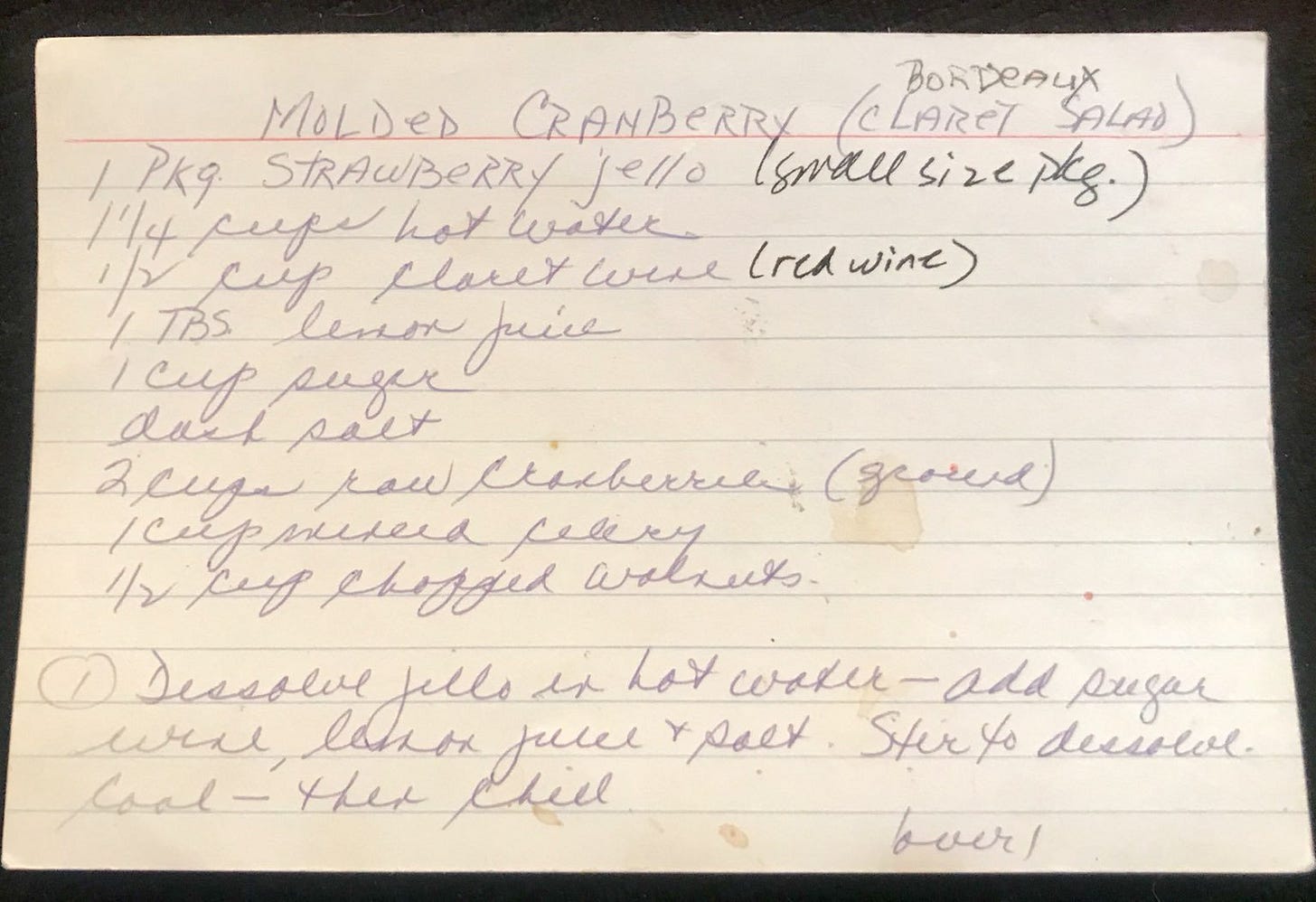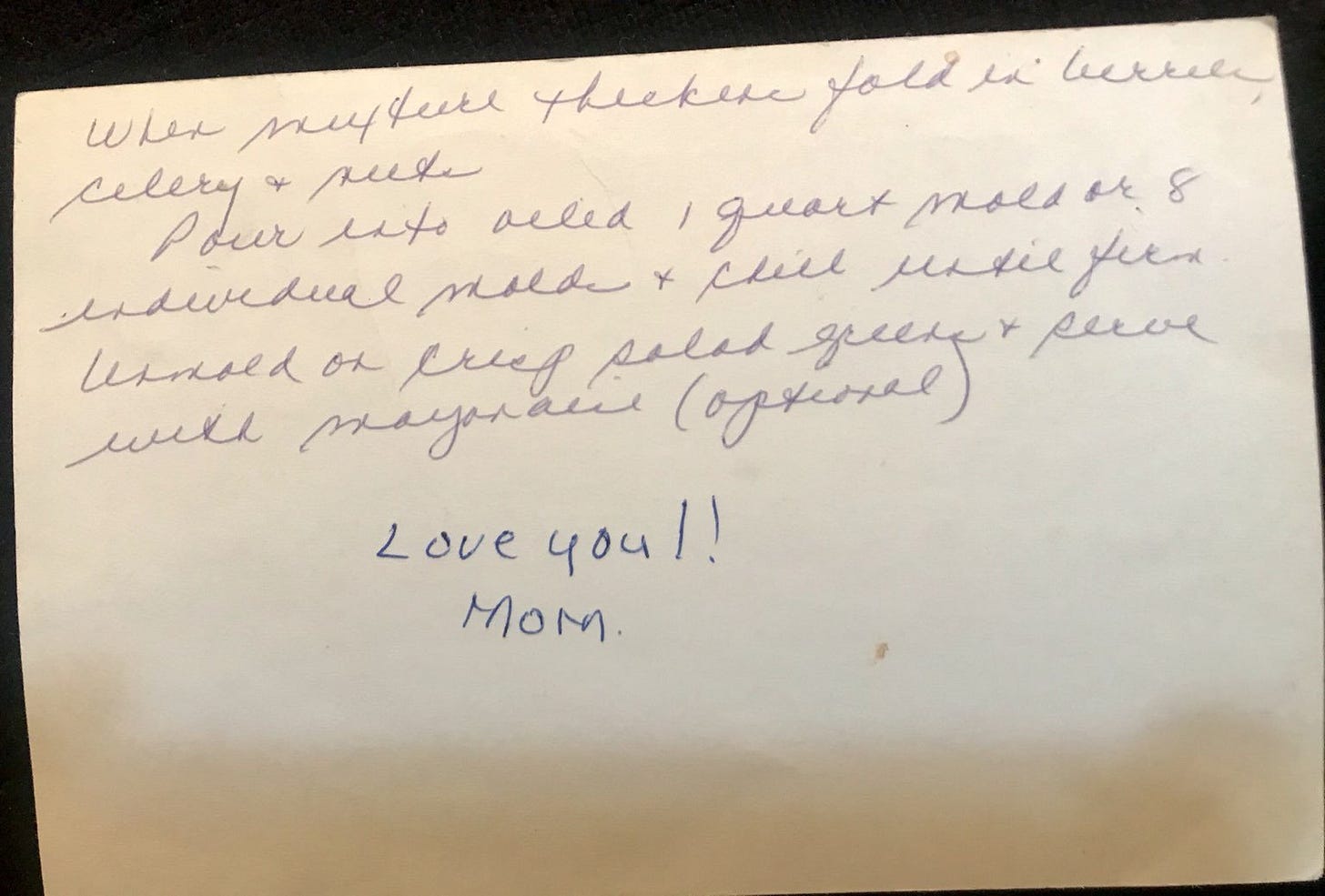When I began promoting The Secret History of Home Economics, I knew that everyone would ask me about practice babies. (And they have.) But I wasn’t expecting such a strong reaction to the Jell-O salad. Some interviewers referred to the genre with disdain and horror. I’ll admit I started it, by mocking a lemon Jell-O “salad pie” chilled in a shell. In fact, I described that dish as a “terrifying and time-consuming monstrosity” in this very newsletter. And I regret that. Because I have come to be bothered by the food media world’s widespread disrespect for Jell-O salad. Even a salad email newsletter I read last month dissed Jell-O salad.
With their interest in nutrition and efficiency, home economics embraced gelatin salad and desserts from the start. Aspic used to be difficult; you had to boil down hooves, and only the wealthy had the staff time to bother. But powdered gelatin—Knox granulated gelatin dates to 1889, and Jell-O sweetened, granulated gelatin to 1897—made that luxury accessible. The ca. 1900 Nampa, Idaho, Century Club’s domestic science cookbook included Jell-O recipes, clearly straight from the Genesee Pure Food Co.— the giveaway being the lack of a contributor name and the line, “Be sure to use Jell-O, with the name Jell-O in big, red letters on the package.”
A 1903 issue of Home Science magazine advertised the trembling concoction cati-corner to the ad for Murray’s Charcoal Tablets (“Don’t Temporize with Drugs — Use Nature Methods”). Two years later, gelatin salad went viral with the Knox contest-winning Perfection Salad, which included cabbage, shredded onions and bell pepper. Laura Shapiro named an entire book about early home economics food after it.
"While in chemical composition gelatin is similar to proteins, it cannot replace them, and it acts merely as 'energy food' and not at all as a building food," the 1915 textbook The Science of Home Making noted. I do not know whether this nutrition fact has held up, but the lightly modified Perfection Salad recipe later in the book has.
This went on. Especially after food companies began hiring home economists to create recipes that promoted their products, but even beyond that. The 1949 textbook Food for Better Living analyzed gelatin’s protein content (2.5 grams per 2 heaping tablespoons) and gave recipes for gelatin dishes both sweet and savory. In the 1950s, Jell-O came in celery flavor. (I wish they’d bring that back: Imagine the chilled Bloody Mary.) Connie Cahill, a “Betty Newton” who worked for Columbia Gas, offhandedly mentioned Jell-O salad when I asked her, a working mom, about her customers: “Mrs. Homemaker wanted to be home. She wanted to make that terrific gelatin salad.”
Sometimes such salads included mayo, sometimes whipped cream as in this Betty Newton potato salad, sometimes Cool Whip … OK, this sentence exists purely to jam in this video:
Why the hate? Some have analyzed: "The Jell-O mold itself was symbolic of the '50s, molding women into what they were supposed to be, after moving them from wartime jobs," a women's studies professor told Judith Weinraub in a 1997 Washington Post article. Moving from sociology to psychology, humans are invariably embarrassed at past efforts to seem sophisticated, caught out for trying too hard.
But mostly I think it’s a class thing, especially a sneering-from-the-coasts thing. And that’s rude. Jell-O salad is not artisanally produced or plucked fresh that morning. It is Southern and midwestern. Former Utah Gov. Gary Herbert recently praised Jell-O in Deseret Magazine, calling it “a symbol of the state’s peculiar exceptionalism: family, faith and social cohesion. It’s a talisman of the granular norms that provide people with purpose, that make life better.”
Really, what’s not to like? We love sweet flavors mixed with savory, whether that be strawberries with balsamic vinegar/black pepper, pears and endive, peanut butter and jelly, salted caramels, General Tso’s chicken or Chubby Hubby ice cream. Texture-wise, jellied products are popular all over the world—think of Filipino buko pandan, coffee jelly, boba tea. Jell-O salads combine that texture with creaminess and crunch, which is even more appealing.
Food writer Judy Walker told me: Jell-O salads tasted great, they were fancy and companies marketed the heck out of them.
I predict the snobbish scorn may soon reverse. After all, everything comes back in time. Jell-O shots have become chic: Solid Wiggles in NYC is cleaning up via Instagram with concoctions that look like flowers or eyeballs or solar systems, most with booze, $85 for a six-inch cake. I had a bite of one at a birthday party, and it tasted like, emmm, a slightly less sweet Jell-O. Can the Jell-O salad revival be far behind?
Book News
I have two particularly fun book events coming up. On Tuesday, Friendly City Books is hosting a virtual event with the Mississippi University for Women. Archivist Vic Jones is poring through the files for photos to share at the event. Sign up. And on Sunday August 9, I’m appearing on site! at the Martha’s Vineyard Book Festival. You can buy a day pass … or stay home and watch the livestream.
And if you want a personalized conversation, invite me! I’m setting up appearances at colleges and conferences for the coming year. I also make free virtual visits to private book groups.
Recipe of the Month
Growing up in the ‘80s in metro NYC, I knew but one Jell-O salad, my maternal grandmother’s, made in a special copper mold for Thanksgiving. Here it is, in Nani’s handwriting, with a few annotations by my mom.
1 small-size pkg. strawberry jello
1-1/4 c. hot water
1/2 c. red wine
1 T lemon juice
1 c. sugar
Dash salt
2 c. raw cranberries, ground
1 c. minced celery
1/2 c. chopped walnuts
Vegetable oil for mold
Salad greens for presentation
Dissolve jello in hot water — add sugar, wine, lemon juice and salt. Stir to dissolve. Cool — then chill. When mixture thickens fold in berries, celery and nuts. Pour into oiled 1 qt. mold and chill until firm. Unmold on crisp salad greens and serve with mayo (optional).
I last made it for Thanksgiving in 2019. Friends tasted with suspicion … then ate with pleasure.
Advance to 5:36 in that Graham Norton clip to hear Seth MacFarlane doing Kermit the Frog doing the speech from Taken. Interested in the cross-stitch pattern I’m designing that says “she wanted to make that terrific gelatin salad”? Email me. You can order my book The Secret History of Home Economics, out now for summer reading! If someone forwarded this email to you, you can subscribe to it here.






I still have the "The New Joys of Jello" cookbook from 1973 and love it! Not that I make Jello anymore but I love the book. :)
Not so much relevant to this post but to your book as a whole, which I thoroughly enjoyed. I'm currently reading *The Hidden Palace" by Helene Wecker, the sequel to "The Golem and the Jinni" (but I think it coulr be read independently), and I don't think it's too much of a spoiler to say that the early 20th century Columbia University Department of Domestic Sciences figures as a plot point. Certainly I wouldn't have appreciated it as much without having read your book.